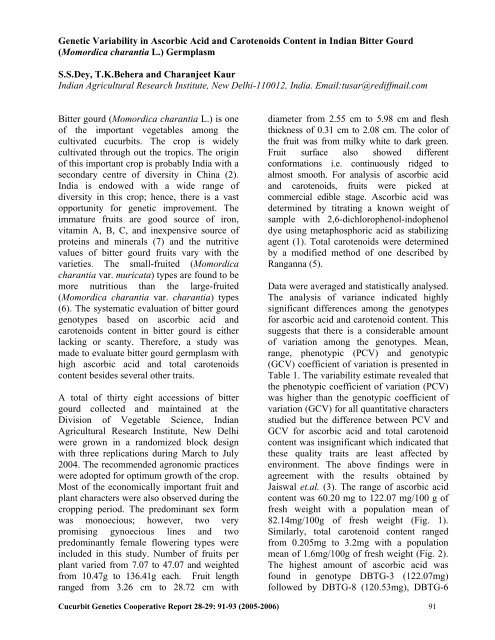Complete volume with articles 1 to 32 - Cucurbit Breeding - North ...
Complete volume with articles 1 to 32 - Cucurbit Breeding - North ...
Complete volume with articles 1 to 32 - Cucurbit Breeding - North ...
Create successful ePaper yourself
Turn your PDF publications into a flip-book with our unique Google optimized e-Paper software.
Genetic Variability in Ascorbic Acid and Carotenoids Content in Indian Bitter Gourd<br />
(Momordica charantia L.) Germplasm<br />
S.S.Dey, T.K.Behera and Charanjeet Kaur<br />
Indian Agricultural Research Institute, New Delhi-110012, India. Email:tusar@rediffmail.com<br />
Bitter gourd (Momordica charantia L.) is one<br />
of the important vegetables among the<br />
cultivated cucurbits. The crop is widely<br />
cultivated through out the tropics. The origin<br />
of this important crop is probably India <strong>with</strong> a<br />
secondary centre of diversity in China (2).<br />
India is endowed <strong>with</strong> a wide range of<br />
diversity in this crop; hence, there is a vast<br />
opportunity for genetic improvement. The<br />
immature fruits are good source of iron,<br />
vitamin A, B, C, and inexpensive source of<br />
proteins and minerals (7) and the nutritive<br />
values of bitter gourd fruits vary <strong>with</strong> the<br />
varieties. The small-fruited (Momordica<br />
charantia var. muricata) types are found <strong>to</strong> be<br />
more nutritious than the large-fruited<br />
(Momordica charantia var. charantia) types<br />
(6). The systematic evaluation of bitter gourd<br />
genotypes based on ascorbic acid and<br />
carotenoids content in bitter gourd is either<br />
lacking or scanty. Therefore, a study was<br />
made <strong>to</strong> evaluate bitter gourd germplasm <strong>with</strong><br />
high ascorbic acid and <strong>to</strong>tal carotenoids<br />
content besides several other traits.<br />
A <strong>to</strong>tal of thirty eight accessions of bitter<br />
gourd collected and maintained at the<br />
Division of Vegetable Science, Indian<br />
Agricultural Research Institute, New Delhi<br />
were grown in a randomized block design<br />
<strong>with</strong> three replications during March <strong>to</strong> July<br />
2004. The recommended agronomic practices<br />
were adopted for optimum growth of the crop.<br />
Most of the economically important fruit and<br />
plant characters were also observed during the<br />
cropping period. The predominant sex form<br />
was monoecious; however, two very<br />
promising gynoecious lines and two<br />
predominantly female flowering types were<br />
included in this study. Number of fruits per<br />
plant varied from 7.07 <strong>to</strong> 47.07 and weighted<br />
from 10.47g <strong>to</strong> 136.41g each. Fruit length<br />
ranged from 3.26 cm <strong>to</strong> 28.72 cm <strong>with</strong><br />
diameter from 2.55 cm <strong>to</strong> 5.98 cm and flesh<br />
thickness of 0.31 cm <strong>to</strong> 2.08 cm. The color of<br />
the fruit was from milky white <strong>to</strong> dark green.<br />
Fruit surface also showed different<br />
conformations i.e. continuously ridged <strong>to</strong><br />
almost smooth. For analysis of ascorbic acid<br />
and carotenoids, fruits were picked at<br />
commercial edible stage. Ascorbic acid was<br />
determined by titrating a known weight of<br />
sample <strong>with</strong> 2,6-dichlorophenol-indophenol<br />
dye using metaphosphoric acid as stabilizing<br />
agent (1). Total carotenoids were determined<br />
by a modified method of one described by<br />
Ranganna (5).<br />
Data were averaged and statistically analysed.<br />
The analysis of variance indicated highly<br />
significant differences among the genotypes<br />
for ascorbic acid and carotenoid content. This<br />
suggests that there is a considerable amount<br />
of variation among the genotypes. Mean,<br />
range, phenotypic (PCV) and genotypic<br />
(GCV) coefficient of variation is presented in<br />
Table 1. The variability estimate revealed that<br />
the phenotypic coefficient of variation (PCV)<br />
was higher than the genotypic coefficient of<br />
variation (GCV) for all quantitative characters<br />
studied but the difference between PCV and<br />
GCV for ascorbic acid and <strong>to</strong>tal carotenoid<br />
content was insignificant which indicated that<br />
these quality traits are least affected by<br />
environment. The above findings were in<br />
agreement <strong>with</strong> the results obtained by<br />
Jaiswal et.al. (3). The range of ascorbic acid<br />
content was 60.20 mg <strong>to</strong> 122.07 mg/100 g of<br />
fresh weight <strong>with</strong> a population mean of<br />
82.14mg/100g of fresh weight (Fig. 1).<br />
Similarly, <strong>to</strong>tal carotenoid content ranged<br />
from 0.205mg <strong>to</strong> 3.2mg <strong>with</strong> a population<br />
mean of 1.6mg/100g of fresh weight (Fig. 2).<br />
The highest amount of ascorbic acid was<br />
found in genotype DBTG-3 (122.07mg)<br />
followed by DBTG-8 (120.53mg), DBTG-6<br />
<strong>Cucurbit</strong> Genetics Cooperative Report 28-29: 91-93 (2005-2006) 91
















